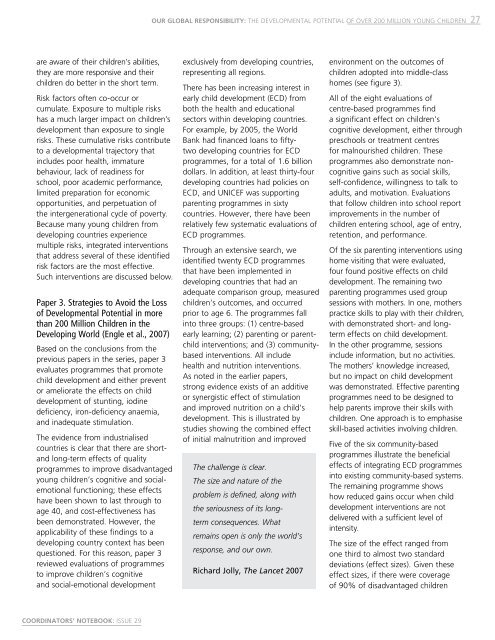A global call to action for early childhood
A global call to action for early childhood
A global call to action for early childhood
Create successful ePaper yourself
Turn your PDF publications into a flip-book with our unique Google optimized e-Paper software.
Our <strong>global</strong> responsibility: The developmental potential of over 200 million young children<br />
27<br />
are aware of their children’s abilities,<br />
they are more responsive and their<br />
children do better in the short term.<br />
Risk fac<strong>to</strong>rs often co-occur or<br />
cumulate. Exposure <strong>to</strong> multiple risks<br />
has a much larger impact on children’s<br />
development than exposure <strong>to</strong> single<br />
risks. These cumulative risks contribute<br />
<strong>to</strong> a developmental trajec<strong>to</strong>ry that<br />
includes poor health, immature<br />
behaviour, lack of readiness <strong>for</strong><br />
school, poor academic per<strong>for</strong>mance,<br />
limited preparation <strong>for</strong> economic<br />
opportunities, and perpetuation of<br />
the intergenerational cycle of poverty.<br />
Because many young children from<br />
developing countries experience<br />
multiple risks, integrated interventions<br />
that address several of these identified<br />
risk fac<strong>to</strong>rs are the most effective.<br />
Such interventions are discussed below.<br />
Paper 3. Strategies <strong>to</strong> Avoid the Loss<br />
of Developmental Potential in more<br />
than 200 Million Children in the<br />
Developing World (Engle et al., 2007)<br />
Based on the conclusions from the<br />
previous papers in the series, paper 3<br />
evaluates programmes that promote<br />
child development and either prevent<br />
or ameliorate the effects on child<br />
development of stunting, iodine<br />
deficiency, iron-deficiency anaemia,<br />
and inadequate stimulation.<br />
The evidence from industrialised<br />
countries is clear that there are shortand<br />
long-term effects of quality<br />
programmes <strong>to</strong> improve disadvantaged<br />
young children’s cognitive and socialemotional<br />
functioning; these effects<br />
have been shown <strong>to</strong> last through <strong>to</strong><br />
age 40, and cost-effectiveness has<br />
been demonstrated. However, the<br />
applicability of these findings <strong>to</strong> a<br />
developing country context has been<br />
questioned. For this reason, paper 3<br />
reviewed evaluations of programmes<br />
<strong>to</strong> improve children’s cognitive<br />
and social-emotional development<br />
exclusively from developing countries,<br />
representing all regions.<br />
There has been increasing interest in<br />
<strong>early</strong> child development (ECD) from<br />
both the health and educational<br />
sec<strong>to</strong>rs within developing countries.<br />
For example, by 2005, the World<br />
Bank had financed loans <strong>to</strong> fiftytwo<br />
developing countries <strong>for</strong> ECD<br />
programmes, <strong>for</strong> a <strong>to</strong>tal of 1.6 billion<br />
dollars. In addition, at least thirty-four<br />
developing countries had policies on<br />
ECD, and UNICEF was supporting<br />
parenting programmes in sixty<br />
countries. However, there have been<br />
relatively few systematic evaluations of<br />
ECD programmes.<br />
Through an extensive search, we<br />
identified twenty ECD programmes<br />
that have been implemented in<br />
developing countries that had an<br />
adequate comparison group, measured<br />
children’s outcomes, and occurred<br />
prior <strong>to</strong> age 6. The programmes fall<br />
in<strong>to</strong> three groups: (1) centre-based<br />
<strong>early</strong> learning; (2) parenting or parentchild<br />
interventions; and (3) communitybased<br />
interventions. All include<br />
health and nutrition interventions.<br />
As noted in the earlier papers,<br />
strong evidence exists of an additive<br />
or synergistic effect of stimulation<br />
and improved nutrition on a child’s<br />
development. This is illustrated by<br />
studies showing the combined effect<br />
of initial malnutrition and improved<br />
The challenge is clear.<br />
The size and nature of the<br />
problem is defined, along with<br />
the seriousness of its longterm<br />
consequences. What<br />
remains open is only the world’s<br />
response, and our own.<br />
Richard Jolly, The Lancet 2007<br />
environment on the outcomes of<br />
children adopted in<strong>to</strong> middle-class<br />
homes (see figure 3).<br />
All of the eight evaluations of<br />
centre-based programmes find<br />
a significant effect on children’s<br />
cognitive development, either through<br />
preschools or treatment centres<br />
<strong>for</strong> malnourished children. These<br />
programmes also demonstrate noncognitive<br />
gains such as social skills,<br />
self-confidence, willingness <strong>to</strong> talk <strong>to</strong><br />
adults, and motivation. Evaluations<br />
that follow children in<strong>to</strong> school report<br />
improvements in the number of<br />
children entering school, age of entry,<br />
retention, and per<strong>for</strong>mance.<br />
Of the six parenting interventions using<br />
home visiting that were evaluated,<br />
four found positive effects on child<br />
development. The remaining two<br />
parenting programmes used group<br />
sessions with mothers. In one, mothers<br />
practice skills <strong>to</strong> play with their children,<br />
with demonstrated short- and longterm<br />
effects on child development.<br />
In the other programme, sessions<br />
include in<strong>for</strong>mation, but no activities.<br />
The mothers’ knowledge increased,<br />
but no impact on child development<br />
was demonstrated. Effective parenting<br />
programmes need <strong>to</strong> be designed <strong>to</strong><br />
help parents improve their skills with<br />
children. One approach is <strong>to</strong> emphasise<br />
skill-based activities involving children.<br />
Five of the six community-based<br />
programmes illustrate the beneficial<br />
effects of integrating ECD programmes<br />
in<strong>to</strong> existing community-based systems.<br />
The remaining programme shows<br />
how reduced gains occur when child<br />
development interventions are not<br />
delivered with a sufficient level of<br />
intensity.<br />
The size of the effect ranged from<br />
one third <strong>to</strong> almost two standard<br />
deviations (effect sizes). Given these<br />
effect sizes, if there were coverage<br />
of 90% of disadvantaged children<br />
COORDINATORS’ NOTEBOOK: ISSUE 29
















